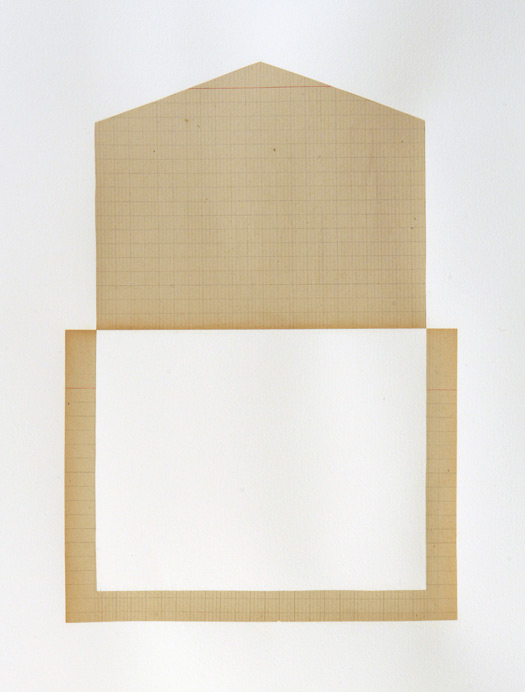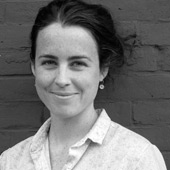
Altonaer Plan 1, 2009, gouache on paper, 22” x 30”. The childhood home of the artist’s father, Gerald (Gerhard) Hass
A bicycle ride in the freezing rain in east Berlin brought artist Emily Hass to the featherbed factory her family owned there before the war. That address was the only concrete piece of information she had about her family’s life in Berlin; her father, Gerald Hass, escaped Berlin in 1938 at age four, but never spoke openly about his experiences in Germany. Although the building that once housed the factory was still standing, it had been converted into a printing press. Nevertheless, Hass managed to gain access to it, and to explore its many rooms and meet its current occupants.
That 2006 visit spurred the Manhattan-based artist’s latest series, SIDES Berlin. For those works, Hass abstracts the forms of Berlin buildings, painting them with gouache or sewing them onto paper with canvas strands. She uses the architectural, sectional, and elevational blueprints as the basis for the study, which she scans during visits to Landesarchiv, Berlin’s central archive. The result is a more or less precise rendering of the plans’ measurements in sweet, crisp shapes. At times, Hass isolates some elements of the plans, to draw parallels between staircases and hallways, say, or one room and another. The results are pithy, robust pieces that transmit emotional information through blueprints — which are often considered objective, mathematical materials that don’t relate a human story.
A bicycle ride in the freezing rain in east Berlin brought artist Emily Hass to the featherbed factory her family owned there before the war. That address was the only concrete piece of information she had about her family’s life in Berlin; her father, Gerald Hass, escaped Berlin in 1938 at age four, but never spoke openly about his experiences in Germany. Although the building that once housed the factory was still standing, it had been converted into a printing press. Nevertheless, Hass managed to gain access to it, and to explore its many rooms and meet its current occupants.
That 2006 visit spurred the Manhattan-based artist’s latest series, SIDES Berlin. For those works, Hass abstracts the forms of Berlin buildings, painting them with gouache or sewing them onto paper with canvas strands. She uses the architectural, sectional, and elevational blueprints as the basis for the study, which she scans during visits to Landesarchiv, Berlin’s central archive. The result is a more or less precise rendering of the plans’ measurements in sweet, crisp shapes. At times, Hass isolates some elements of the plans, to draw parallels between staircases and hallways, say, or one room and another. The results are pithy, robust pieces that transmit emotional information through blueprints — which are often considered objective, mathematical materials that don’t relate a human story.
With master’s degrees in both psychology and design from Harvard University, Hass, who currently teaches interior design at Parsons, has spent a lot of time thinking about the psychology of space. She began graduate school believing she wanted to be a therapist, but her interest in the relationship of psychology and architecture led her to cross-register in classes on design, and eventually pursue a second masters in architectural theory at Harvard’s Graduate School of Design. Hass cites Gaston Bachelard, Carl Jung and Beatriz Colomina among her scholarly influences. In terms of visual artists, Hass claims Gordon Matta-Clark, Eva Hesse, Blinky Palermo, Luc Tuymans and Agnes Martin as inspiration — influences that are made clear in her sensitivity to line, contrast in color, and emphasis on materials.
Nina Katchadourian, Viewing Program curator at The Drawing Center, compares SIDES Berlin to the work of Bernd and Hilla Becher and Shimon Attie. The Bechers’ large-format photographs of German industrial buildings in the 1960s and ’70s provide a similar typological study as SIDES Berlin, but Hass’s project is a different kind of inventory: she catalogs buildings that are defined by a certain kind of history, not function or design. Like Shimon Attie — who made a series in the ’90s called The Writing on The Wall, which projected images of pre-Holocaust historical photographs of Berlin Jews onto the sites where the photographs had been originally taken, evoking the overlap between past and present — Hass is interested in the role that memory plays in the contemporary German landscape.

Bond St 3, 2005–7, vintage graph on paper, 22” x 30”
Though she always had a strong visual life, says the soft-spoken, thirty-nine year old artist, it wasn’t until she was in her late twenties that she began to communicate that vision as art, when she signed up for a figure painting class at Harvard. But she found that she preferred to draw the space around the model, rather than the figure itself. A few years later, Hass began what would be the prelude to her Berlin series: SIDES New York. For that body of work, Hass photographed the exterior walls in New York that showed the seams of demolished buildings. Onto heavy paper stock, she then sewed, collaged, and perforated the shapes of these palimpsests of buildings past. This typological study — the artist devoted five years to the project — reveals the nature of lost forms and explores the psychological impact of the visual footprint that is left by architectural history.
Two years after her first trip to Berlin, Niklas Maak — the art and architecture critic of the newspaper Frankfurter Allgemeine Zeitung — visited Hass’s airy studio in New York’s meatpacking district. She shared SIDES New York with him, and told of her idea to expand the series to Berlin, so that she could tell of her own family’s history and loss. At Maak’s invitation, Hass, one of her two sisters, her mother, and her father returned to Berlin in the summer of 2008, the first time Dr. Hass had been back to the city since he fled seventy years before. During that ten-day trip, with the help of a family friend, the artist found her way to Landesarchiv. Though her father’s home is no longer standing (the site is now part of the Tiergarten), she located the building plans. A McCloy grant the following year enabled Hass to return to Berlin to expand the series; she has since located the plans for buildings that once housed other former Berlin Jews, including Josef Albers, Anni Albers, Mike Nichols and Walter Benjamin, among others.
Like SIDES New York, SIDES Berlin aims to provide a record of loss, and at the same time is invested in re-imagining the spaces as they were before the war, in an effort to fill that void. “These spaces died,” Hass says. “I want to validate that they did live and give them a new life in the process.” Nevertheless, the somber works cannot help but evoke lives interrupted — and the echoing silence that followed.

Sensenburgerallee, 28 Section 1, 2009, gouache on paper, 19” x 23”. The former residence of Josef and Anni Albers
Emily Hass is returning to Berlin this month to continue her archival research. In 2011 she will be an artist-in-residence at the Josef and Anni Albers Foundation in Bethany, Connecticut. Her work is part of the Flat File program at Pierogi 2000 and the Drawing Center’s Viewing Program, both in New York.
Emily Hass is returning to Berlin this month to continue her archival research. In 2011 she will be an artist-in-residence at the Josef and Anni Albers Foundation in Bethany, Connecticut. Her work is part of the Flat File program at Pierogi 2000 and the Drawing Center’s Viewing Program, both in New York.


